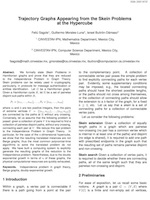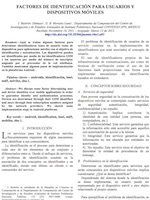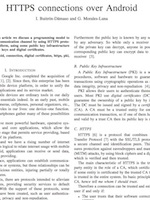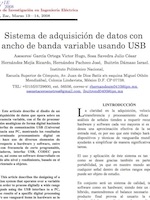Publicaciones
Filtro:
Orden:
Trajectory Graphs Appearing from the Skein Problems at the Hypercube
Revista
Revista Computación y Sistemas, Volumen 20, No. 1 (2016)
Publication year: 2016

Resumen
We formally state Skein Problems in Hamiltonian graphs and prove that they are reduced to the Independence Problem in Graph Theory. Skein problems can be widely used in cryptography, particularly, in protocols for message authentication or entities identification. Let G be a Hamiltonian graph. Given a Hamiltonian cycle H, let Π be a set of pairwise disjoint sub-paths within H, P1 = [v11, . . . , vm1], . . . , Pk = [v1k, . . . , vmk] where m and k are two positive integers, then the pairs of extreme vertices V = {(v11, vm1), . . . , (v1k, vmk)} are connected by the paths at Π without any crossing.
Conversely, let us assume that the following problem is posed: given a collection of pairs V it is required to find a collection of pairwise disjoint paths, without any crossing, connecting each pair at V. We reduce this last problem to the Independence Problem in Graph Theory. In particular, for the case of the n-dimensional hypercube, we show that the resulting translated instances are not Berge graphs, thus the most common polynomial-time algorithms to solve the translated problem do not apply. We have built a computing system to explicitly generate the resulting graphs of the reduction to the Independence problem. Nevertheless, due to the doubly exponential growth in terms of n of these graphs, the physical computational resources are quickly exhausted.
Factores de identificación para usuarios y dispositivos móviles
Conferencia
Puente Revista Científica Universidad Pontificia Bolivariana, Volumen 6, Número 1, 2012

Resumen
Aquí se tratan algunos factores para determinar identificadores tanto de usuario como de dispositivos para aplicaciones móviles con el objetivo de identificación y autenticación. Los dispositivos pueden ser identificados por medio de los identificadores GSM y los usuarios por medio del número de suscriptor asignado por el proveedor de la red telefónica. También mostramos algunos pasos de implementación en la plataforma Android.
Abstract
We discuss some factor determining user and device identities over mobile applications in order to guarantee identity and authentication processes. Devices are determined through their GSM identifiers and users through their subscription numbers assigned by the network providers. We sketch some implementation steps in Android platforms.
DOI
HTTPS connections over Android
Conferencia
Electrical Engineering Computing Science and Automatic Control (CCE), 2011 8th International Conference on. IEEE, 2011

Abstract
In this article we discuss a programming model to establish a secure communication channel by using HTTPS protocol in Android platform, using some public key infrastructure features like public keys and digital certificates.
Sistema de adquisición de datos con ancho de banda variable usando USB
Conferencia
Electrical Engineering Computing Science and Automatic Control (CCE), 2011 8th International Conference on. IEEE, 2011

Resumen
Este articulo describe el diseño de un sistema de adquisición de datos que opera sobre un rango de frecuencia variable, con el fin de procesar diversas señales analógicas de forma digital haciendo uso de la interfaz de comunicación USB (Universal Serial Bus) hacia una PC, mostrando los resultados de un determinado procesamiento digital en pantalla. Se hace uso de diversos elementos de vanguardia respecto a hardware y software, entre ellos filtros con frecuencia de corte programable, microcontroladores, interfaz USB, CODEC para análisis de voz, así como un software desarrollado en un lenguaje de alto nivel y rendimiento, basado en el paradigma orientado a objetos.